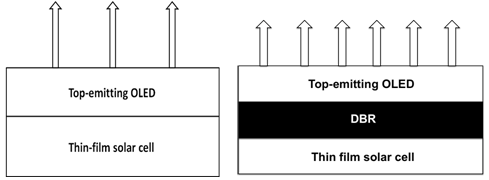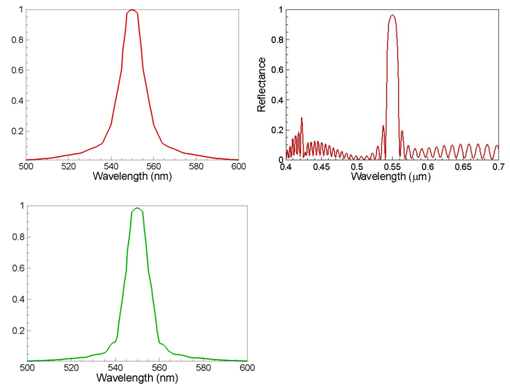|
Investigation of the diffusion length of the cathodes in OLEDs through the impedance characteristics
Professor
Chih-I Wu's Laboratory
Graduate Institute of Photonics and
Optoelectronics, National Taiwan University
臺灣大學光電所 吳志毅教授
For typical organic light emitting devices (OLEDs) with the hole mobility much larger than the electron mobility, the impedance versus voltage (Z-V) characteristics show a particular behavior which can be used to investigate many electrical properties of the organic layers. The impedance of these devices presents a transition from a higher value to a lower value before the device turns on, which indicates that the hole transport layer (HTL) reaches flat band and becomes conductive first. The voltage at where this transition occurs is named the transition voltage, and the difference between the transition voltage and the turn on voltage is dependent on the thickness of the electron transport layer (ETL) and the density of the accumulation charges.
In this work, devices with systematically varied thicknesses of ETLs and four kinds of cathode structures were investigated. The transition voltages versus the thickness of the ETL characteristics in Fig. 1 show that the transition voltages of the devices with an electron injection layer (EIL) shift toward higher bias while the slopes of all these devices remain constant. The shift of the transition voltage is proposed to result from the diffusion of the cathode structures into the organic layers which decreases the effective thickness of the ETL for capacitances. Therefore, the diffusion length of these cathodes can be estimated from the shift of the transition voltages of each group of devices.
|
 |
|
Fig.1 The transition voltage V0 versus thickness of the ETL (Alq3) characteristics. The film structures of these devices are
ITO/NPB(800Å)/Alq3/cathodes.
|
Tumor detection strategy using ZnO light emitting nano-probes
Professor
Jian-Jang Huang
Graduate Institute of Photonics and
Optoelectronics, National Taiwan University
臺灣大學光電所 黃建璋教授
Traditional methods of detecting cancer cells, such as fluorescence, have their limits and can hardly be used for identification during tumor resection. Here we report an alternative tumor detection technology using ZnO nanorods bonded to antibodies as cancer cell probes. Our experiment shows that EGFR(Epidermal growth factor receptor) can be connected to ZnO nanorods and to EGF receptors of SCC(squamous cell carcinoma). The cancer cell can be recognized by the bare eye or the optical microscope with the help of purple light emission from ZnO/EGFR antibody probes. On the other hand, for cells with less expression to EGFR, in our case HS68, no purple light was observed as the probes were washed-off. From the photoluminescent spectra, the peak intensity ratio between the purple light (from ZnO at the wavelength 377nm) and the green band (from the auto-fluorescence of cells) is much higher with the presence of SCC, as compared with HS68. The ZnO/EGFR antibody probes have the potential to be applied to real time surgery for tumor cell identification. The cancer cells will be excised with the help of purple light emission.
Luminous-efficiency improvement of solar-cell-integrated high-contrast organic light-emitting diode by applying distributed Bragg reflector
Professor
Hoang-Yan Lin
Graduate Institute of Photonics and
Optoelectronics, National Taiwan University
臺灣大學光電所 林晃巖教授
Solar-cell-integrated organic light-emitting diodes (OLEDs) were fabricated with both high contrast ratio and energy-recycling ability. However, the luminous efficiency of the integrated devices is reduced to 50% of that of conventional top-emitting OLEDs. A novel structure to recover the luminous efficiency from 50% to near 85% by applying a distributed Bragg reflector (DBR) was demonstrated. It saves about 40% of the electric power of that of a device without a DBR. The contrast ratio remains high compared to that of conventional OLEDs. Simulations were conducted first to prove our models and assumptions. Then, two types of thin-film solar cells – CdTe and CIGS solar cells – were used. They had different contrast ratios as well as viewing-angle properties. Finally, the emission spectrum was calculated to be 11 nm FWHM, which is narrower than that for the emission spectrum of a typical microcavity OLED and has the advantage of having saturated colors.
|
 |
|
Fig. 1 (a) Concept of the solar-cell-integrated OLED; (b) concept of our DBR design; integration of a DBR to enhance the outcoupling efficiency.
|
 |
|
Fig. 2 (a) Input microcavity-OLED emission spectrum; (b) DBR reflectance of a CdTe solar-cell-integrated OLED; (c) output microcavity-OLED emission spectrum for a CdTe solar-cell-integrated OLED. |
|